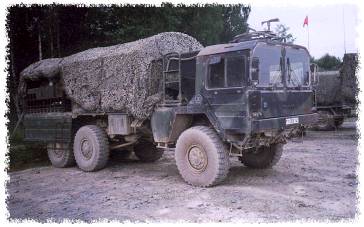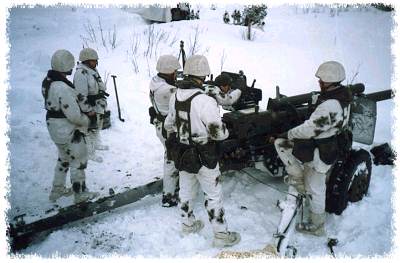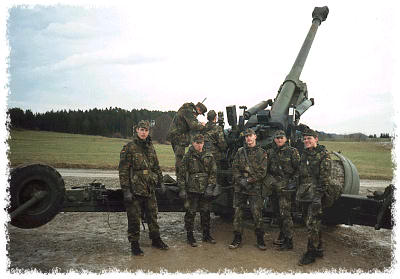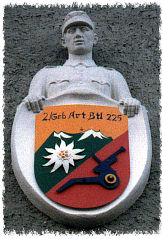2./Gebirgsartilleriebataillion
225
2 Battery 225 Mountain Artillery
Battalion
Peter Linau gives us this interesting
account of life as a modern Gebirgsjäger
Das Gebirgsartilleriebataillion 225
(225th Mountain Artillery Battalion)
The battalion consists of 4 batterys (Batterien-Bttr.)
1.Bttr. is the staff and supplybattery
(Stabs-und Versorgungsbatterie) which is also the largest, with over 200
soldiers.
2.Bttr., 3 and 4 Bttr. are
the shooting batterys.
Stationed in our barracks were also the 1st and
4th kompany from Gebirgsinstand-setzungsbataillion 8 (8th Mtn.Maintenance
Btl.) and 3rd kompany of Nachschub-bataillion 4 (4th Supplybattalion).
|
|
|
Oberfreiter Linau. Peter
2./ Gebirgsartilleriebataillion 225 im Dienstanzug.
My time in the "Zwote" 2nd battery:
In the first 3 months we had Grundausbildung
(basic training) in cold-wet weather. It was hard and an experience for
a lifetime. Even though the weapons, equipment and insignia have changed
a little, the tactics in training and formations are still much like that
of the Wehrmacht. (Why change something if it’s so good).
We had countless formation (Antreten, Ausrichten,
and Gleichschritt marschieren) training in which mainly infantry tactics
were taught; also use of NBC equipment, small arms And weapons, survival
and live firing with the Heckler u.Koch Sturmgewehr G-3, P-1 Pistole (P-38),
MG-3 (42), the use of Handgranaten and the Panzerfaust. How to fight at
night and in urban terrain.
We had much Sport (physical training);
running from 100meters up to 5000m, swimming and much more. All this had
to be accomplished to earn the Sport und Leistungsabzeichen (physical excellence
badge).
|
|
|
| Mein Standort Füssen, das Gebirgsartilleriebataillion
225, 1 Gebirgsdivision
History:
I was stationed in Füssen, Bavaria
which is a very old town. In the Year 170 AD the Romans built a fort and
stationed their supply unit staff there to protect the important business
street "Via Claudia Augusta" (that crossed from north Italy to Augsburg
Germany) from the attacking Alemanns (rebels). In the year 1796 small civilian
troops (Buergerwehr) volunteered with just 40-armed men to defend the town
against criminals and rebels. As the French in Moreau penetrated into Pfronten
(only about 15 Kilometers from Füssen) and captured the town, the
Buergerwehr became larger. In 1802 the Bavaria light Infantry (kur-bayerische)
fought against the French and won the town back. From then on border patrol
and reconnaissance troops were stationed in Füssen.
On March 16th 1935 conscription into the
military was put into place. The 1st Gebirgs-Division was formed in 1938
in Garmisch partenkirchen and became the founder for all future Gebirgs
and SS Gebirgsdivisions. Since Füssen is in the Alps, it is the ideal
location for the Gebirgstruppen to be stationed. On October 1936 Oberst
Dietl with regiment staff, the 2nd battalion and 14th kompany from Geb.Jäger
Rgt.99 moved into the new barracks. During World war two the 5th Mountainschool
(Heeresfach-schule 5) and recruiting office (Wehrmeldeamt) was active.
At the end of WWII U.S. armed forces controlled the barracks and it was
used for repatriation. The barracks changed its name several times. In
1958 it was named Jägerkaserne, and the Gebirgsflugabwehrbataillion
8 (8th Mtn.Ada.Bn.) of todays German Army (the Bundeswehr) moved in.
In the following years many other units
of the Bundeswehr became stationed there. In 1964 the barracks were renamed
"General Oberst Dietl Kaserne". The current Gebirgsartilleriebataillion
225 moved in 1970 and was the unit I served in.
to be continued......
|
| Gefreiter Linau Peter H. 2./225 Geb. Art.
Btl - Norway 96.
After these 3 hard months the next 3 months
we had spezielle Grundausbildung
(Military occupational speciality, MOS). Mine
was Kanonier (canoneer) on the
Feldhaubitze (FH) 105 and FH-70 (155-1).
We trained day and night and the training
was stressed to us so hard as to be the best for our first live-firing
exercise soon to be in northern Norway. Our FH –105’s were shipped to Narvik
while we flew by plane. Heated canvas tents were set up for us already
by part of our troops that had arrived earlier.
|
|
|
| Out of the 4 1/2 weeks we were stationed
there, we fired live ammunition for 3 weeks with our NATO partners, and
6 days we were out in the snow for the main exercise with over 15000 soldiers
from different nations.
And it came to truth; our battalion shot
the most accurate on the gridsquares!
|
|
|
| After all the successful shooting we celebrated and the battery
gave out free rounds of beer. The next day we had off and busses took us
to Trams to enjoy the nice town. The last challenge for us was the biathlon
for the artic patch; 10 km skiing and shooting targets with the Sturmgewehr
G-3. The next few days we had maintenance and cleaning of the Haubitzen,
vehicles, equipment, and pulled down the tents.
As we arrived back to Füssen the break was only short and
the stress soon continued with further training on the heavy artillery
gun FH-70, the battalions main weapon. A battery has 3 Platoons (Zuege).
1st and 2nd Platoon each armed with 4 Howitzers; the 3rd Platoon (Zug)
is the Feuerleittrupp (Fire command squad) that calculate and count the
shots, also there is the Richtkreistrupp (survey and navigation squad)
that makes sure the howitzers are in the fireposition and shoot in the
right direction. The last squad in the 3rd Zug is the Beobachter (observer);
they are the "eye" of the artillery and are in close combat to the enemy.
They give forward information to the Feuerleittrupp which calculates shooting
distance (Teilring), type of ammunition, fuse timing and propelling charge
(Treibladung). The Siebentonner M.A.N., (7ton truck) and we 6 Kanoniers
tow the Feldhaubitze with ammunition sitting in the back ready to hear
orders from our Unteroffizier (sergeant) sitting in front next to our Kraftfahrer
(driver).
|
Technical
Data:
(155-1) |
FH-105 |
FH-70 |
| Calibre |
105mm |
155mm |
| Weight of FH |
2,5 t |
9,6t |
| Weight of ammo |
15kg |
>43kg |
| Range |
14,1Km |
25Km |
| Towing vehicle |
Siebentonner |
7ton truck |
| Crew |
|
|
1 Unteroffizier
(1 sergeant) |
|
|
1 Kraftfahrer
(1 driver) |
|
|
5 Kanoniere
(5 canoneers) |
|
|
|
|
|
Basic training in Füssen, Bavaria Oct. 95
Kanoniere: from left; S. Hofelich, Achtelik,
W. Imrich and P. linau. |
|
 |
| Lastkraftwagen "Siebentonner" M.A.N towing vehicle
Engine output: 320 hp
Speed: 90km/h
Range: 450km
Climbing Rate: 50%
Fuel Consumption: 60L/100km
Armament:1 x 7.62mm MG-3 (42) mounting on top of cabin
|
|
| Our Training:
Suddenly the 7t Truck stopped somewhere
out in the field, our Uffz shouted: "Wirkungsbereitschaft herstellen!"
The truckdoor opened and we jumped out and sprinted to the Haubitze, brought
it into position, set up the sights, threw over the camo net and erected
it (which was always a pain, because it gets caught on almost anything).
Everybody had to do his job extremely fast, the Haubitze had to be in firing
position and camouflaged in less than 6 minutes.
After everything was set up we practiced,
"Trockenuebung", and acted as if we were shooting. As the last round out
of three was shot our Uffz shouted: Stellungswechsel!" (move out!). We
moved again, so fast... tore down the camo net, rolled it up quickly, removed
the sights, hooked on the Feldhaubitze and jumped in the truck. It was
rolling us through the terrain for just a few kilometers and then the whole
procedure repeated again; "Wirkungsbereitschaft herstellen!"....“Stellungswechsel!"
all day long. Weeks went by, with just training and Sport (PT). In May
our next exercise was to come; life firing, but this time with the "Schwere
Feldhaubitze" FH-70 in the training fields of Baumholder, together with
the 4th artillery Regiment. Again our shooting was done successfully.
After those two weeks we went back to Füssen in our convoys. About
15 days we had more of a relaxed time, doing maintenance on the weapons
and vehicles and had physical training. In June we got ready for our final
live firing exercise in Grafenwoehr.
For two weeks again we fired many rounds
in the extreme heat with surrounding mosquitos physically trying to break
us down. Guard duty every night with only 4 hours of sleep, making us very
tired. Protecting the crew in the truck by standing in the front cabin
MG-post, pressing the MG-3 (42) against my shoulder and scanning the dusty
gravel road ahead while driving 60 km/h. Again we arrived at the next shooting
range to fire off more rounds. The fire was massive.
After the exercise we drove back in convoys
on the Autobahn back to Füssen. For a few more weeks we maintained
the weapons, vehicles and equipment. Our time in the Army was almost over
and everybody was celebrating and drinking. A few of us and myself didn’t
do the same because we actually liked the unit so much that we planned
on staying longer. There were options available to only a few soldiers
to extend their duty, monthwise or yearwise and for pay that was not bad.
A minimum of at least 2 months or up to 13 months or even 4 years or longer
were options. I decided to stay for 5 more months, so my time in the "Zwote"
came to 15 months in total. In August Unteroffiziere from Mittenwald (the
Geb.Jäger Btl.233) came to Füssen to instruct us about mountain
climbing. The next few weeks after the class we climbed in the Alps over
2000 meters, it was a pure challenge.
From the soldiers who had finished duty
and left, our battery was now almost empty, consisting only of volunteered
soldiers, mostly Unteroffiziere and Officers. I became promoted to Hauptgefreiter
(corporal) and was now able to give orders to the new recruits and help
train them. They (about 90 of them) soon arrived. The battery was now filled
again, and these were to be trained just like we were a year ago. Together
with the Unteroffiziere we trained them mostly Infantry tactics and formation.
After these 2 months of training my time in the "Zwote" moved closer to
its end. There was a special battery formation set for me, with honour
and gratitude.
...It was a strange feeling to leave the
gate saluting the guards and knowing that I would not be coming back again.
I could have stayed longer, but as we know the day will come for most of
us to get back to civilian life, some day.
Gott mit Uns, Horrido, Berg Heil!
I left the Army in 1996, since then the
battalion hasn’t changed.
Hauptgefreiter LINAU, P
2. /Gebirgsartilleriebataillion 225
|
| Towed Field Howitzer FH 105 in Norway Feb. 96.
Operation Battle Griffin. |
|
 |
 |
| Complete Cannon crew of seven Canoneers in Baumholder,
Germany during May 96. |
|
|
Mein Standort Fuessen,das Gebirgsartilleriebataillion
225, 1 Gebirgsdivision
Thanks to Peter Linau and Gebirgsartilleriebataillion
225, 1 Gebirgsdivision for this material
|
|
|

